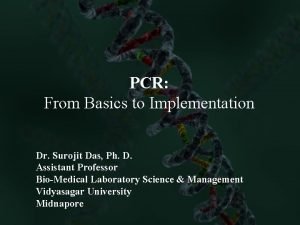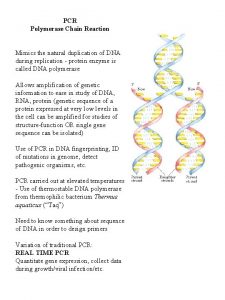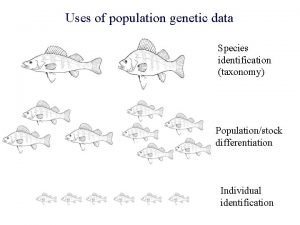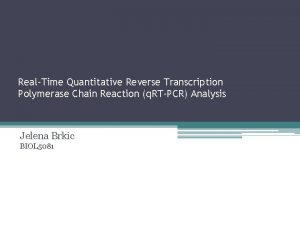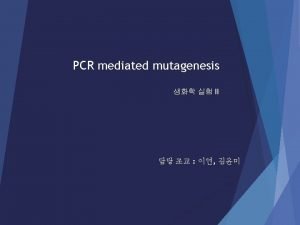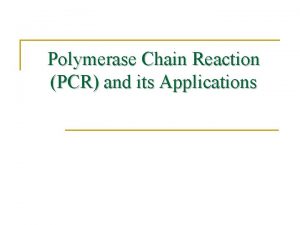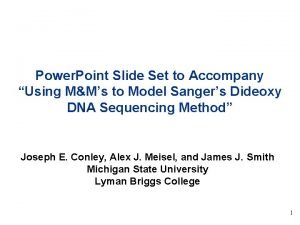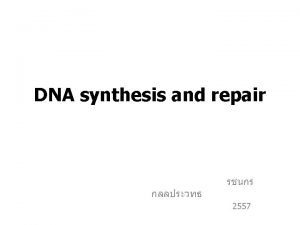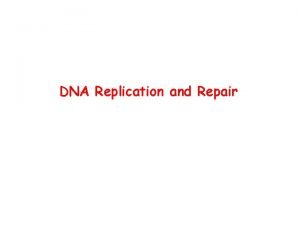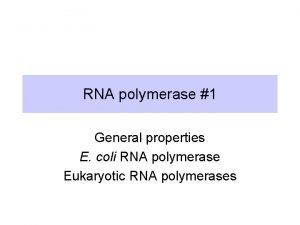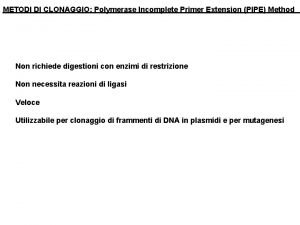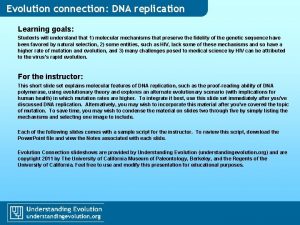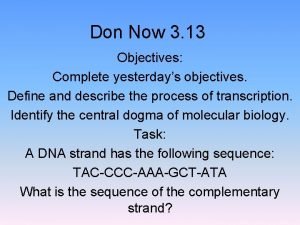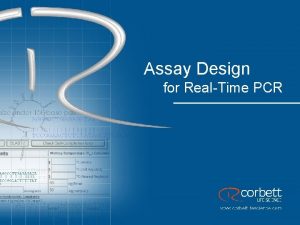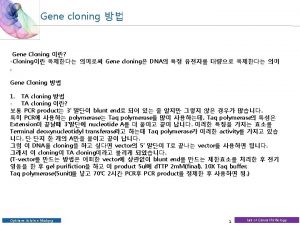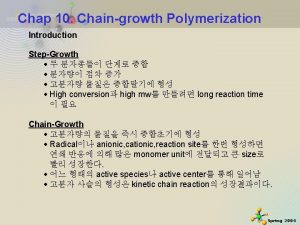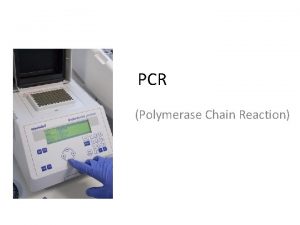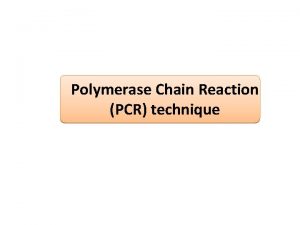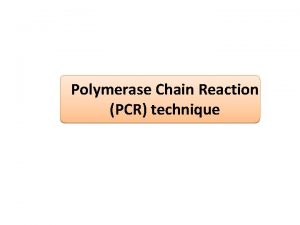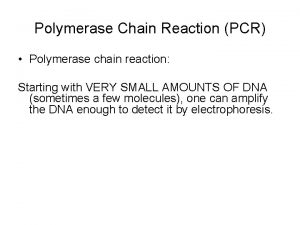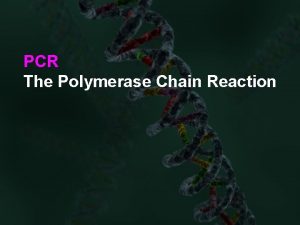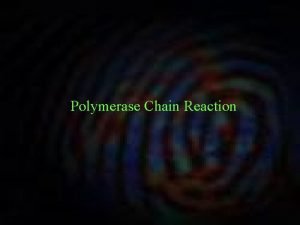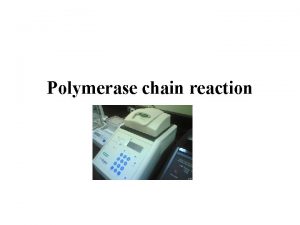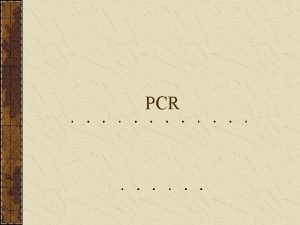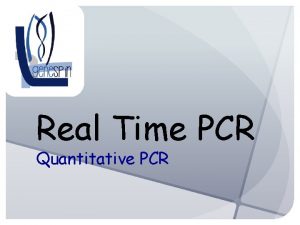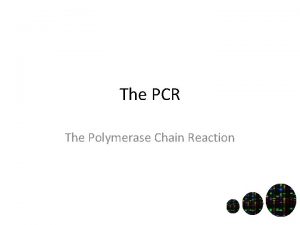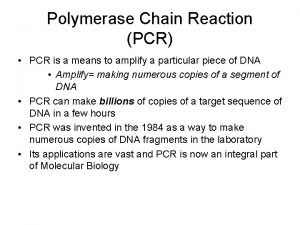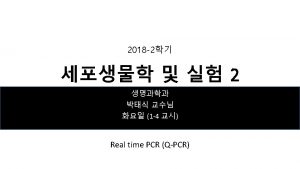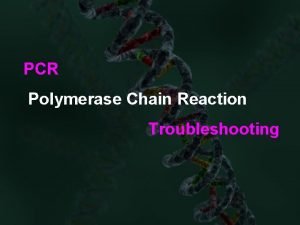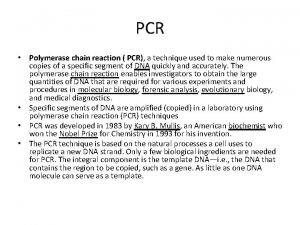Polymerase chain reaction What is PCR PCR Polymerase































- Slides: 31

Polymerase chain reaction

What is PCR? PCR- Polymerase Chain Reaction PCR is a technique that takes a specific sequence of DNA of small amounts and amplifies it to be used for further testing

Kerry Mullis's PCR Idea “lets you pick the piece of DNA you’re interested in and have as much of it as you want”.

The history of the Polymerase Chain Reaction Cooperative teamwork of many researchers. A list of some of the events before, during, and after its development: ØOn April 25, 1953 James D. Watson and Francis Crick published "a radically different structure" for DNA thereby founding the field of molecular genetics ØStarting in the mid 1950 s, Arthur Kornberg began to study the mechanism of DNA replication By 1957 he has identified the first DNA polymerase

In 1969 Thomas D. Brock reported the isolation of a new species of bacterium from a hot spring in Yellowstone National Park. Thermus aquaticus (Taq), Taq polymerase isolated by Chien et al. in 1976 became a standard source of enzymes able to withstand higher temperatures than those from E. Coli In 1970 Klenow reported a modified version of DNA Polymerase I from E. coli. Treatment with a protease removed the 'forward' nuclease activity of this enzyme. The overall activity of the resulting Klenow fragment is therefore biased towards the synthesis of DNA, rather than its degradation

PCR Targets The targets in PCR are the sequences of DNA on each end of region of interest, which can be a complete gene or a small sequence.

The “Reaction” Components n n n Target DNA - contains the sequence to be amplified Pair of Primers - oligonucleotides that define the sequence to be amplified. d. NTPs - deoxynucleotidetriphosphates: DNA building blocks. Thermostable DNA Polymerase - enzyme that catalyzes the reaction Mg++ ions - cofactor of the enzyme Buffer solution – maintains p. H and ionic strength of the reaction solution suitable for the activity of the enzyme

The Reaction PCR tube THERMOCYCLER


PCR Cycles Review n Denaturalization: n Primer 94°- 95°C Annealing: 55°- 65°C n Extension n Number of DNA: 72° of Cycles: 25 -40

PCR Denaturing Denaturation is the first step in PCR, in which the DNA strands are separated by heating to 95°C.

PCR Cycles

PCR Primers range from 15 to 30 nucleotides, are single-stranded, and are used for the complementary building blocks of the target sequence.

PCR Primers A primer for each target sequence on the end of your DNA is needed. This allows both strands to be copied simultaneously in both directions.

PCR Annealing is the process of allowing two sequences of DNA to form hydrogen bonds. The annealing of the target sequences and primers is done by cooling the DNA to 55°C.

PCR Cycles

PCR Taq DNA Polymerase Taq stands for Thermus aquaticus, which is a microbe found in 176°F hot springs in Yellow Stone National Forest.

PCR Taq DNA Polymerase Taq produces an enzyme called DNA polymerase, that amplifies the DNA from the primers by the polymerase chain reaction, in the presence of Mg.

PCR Cycles






RT-PCR

Synthesis of Gene


LA-PCR Long accurate PCR

Nested Primer

Real Time Quantitative PCR

Applications of PCR Basic Research • Mutation screening Applied Research • Genetic matching • Drug discovery • Detection of pathogens • Classification of organisms • Pre-natal diagnosis • Genotyping • DNA fingerprinting • Molecular Archaeology • Gene therapy • Molecular Epidemiology • Molecular Ecology • Bioinformatics • Genomic cloning • Site-directed mutagenesis • Gene expression studies
 Applications pcr
Applications pcr Pcr phases
Pcr phases Polymerase chain reaction
Polymerase chain reaction Polymerase chain reaction
Polymerase chain reaction Polymerase chain reaction
Polymerase chain reaction The three steps of polymerase chain reaction
The three steps of polymerase chain reaction Site:slidetodoc.com
Site:slidetodoc.com Grazing food chain diagram
Grazing food chain diagram Half life formula
Half life formula Rate law
Rate law Addition reaction and substitution reaction
Addition reaction and substitution reaction Leukoerythroblastic reaction vs leukemoid reaction
Leukoerythroblastic reaction vs leukemoid reaction Dna polymerase
Dna polymerase Rna polymerase
Rna polymerase Dna polymerase proofreading
Dna polymerase proofreading Dna polymerase
Dna polymerase Transcription initiation in eukaryotes
Transcription initiation in eukaryotes Rna polymerase 1 2 3
Rna polymerase 1 2 3 Polilynker
Polilynker Types of dna polymerase in eukaryotes
Types of dna polymerase in eukaryotes What are the enzymes involved in dna replication
What are the enzymes involved in dna replication Dna polymerase
Dna polymerase Dna polymerase
Dna polymerase Adn polymérase
Adn polymérase Types of dna polymerase in eukaryotes
Types of dna polymerase in eukaryotes Template strand, new strand, base pair, and dna polymerase.
Template strand, new strand, base pair, and dna polymerase. Intron pcr
Intron pcr Replication
Replication Dna polymerase iii
Dna polymerase iii Taq polymerase
Taq polymerase Demings chain reaction
Demings chain reaction Step-growth polymerization
Step-growth polymerization
